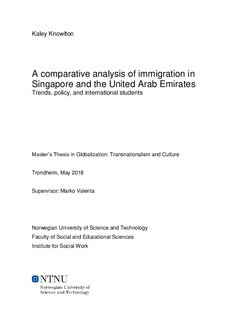| dc.description.abstract | This thesis is a comparative analysis of three aspects of migration in two countries with liberal immigration systems: Singapore and the United Arab Emirates (UAE). These three aspects explored in this thesis are immigration trends, immigration policy, and international student migration. This thesis compared these three aspects in both Singapore and the UAE. It also explores the interrelations between these three aspects. This thesis examines both why these countries are attractive destinations for migrants and why these countries encourage migration through liberal policies.
This thesis is the result of a desk study. Reports and studies sanctioned by the Singaporean and Emirati governments comprise the majority of the sources used in this thesis. News articles and reports from non-governmental entities were also used to collect data. Data collected included statistics, law and policy documents, and press releases which related to the aspects of migration which were explored in this thesis. This data was qualitatively analyzed to gain an understanding of receiving migration in both countries and to understand the motivations behind both countries’ immigration policies.
The push-pull model was the theory most employed in the analytical chapters of this thesis. It was supplemented with other theories and frameworks to address the weaknesses of the push-pull model. Using this model, I identified some factors that make Singapore and the UAE attractive destination countries. Both countries attract labor migrants of all skill levels who come for the prospect of good opportunities and higher wages. I discuss how a liberal migration policy facilitates this inward flow of migrants. However, these countries, in particular the UAE, have more restrictive integration policies and challenges to continued legal status that can act as a push factor causing return migration.
Both countries use migration to benefit the development of the country, namely to strengthen their economy. One of the main goals exhibited by both countries is attracting skilled migrants to contribute to the prosperity of the workforce and to further develop the country into a knowledge economy. International education is also used to promote research and attract and train talent. | nb_NO |
